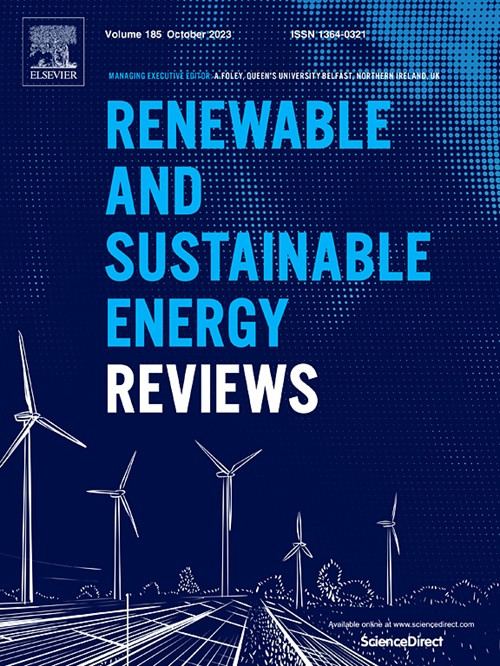Advancements in coupling strategies for urban microclimate and building energy models
IF 16.3
1区 工程技术
Q1 ENERGY & FUELS
引用次数: 0
Abstract
Urban microclimates within metropolitan landscapes exhibit pronounced deviations from their rural counterparts, exerting a substantial influence on building energy performance. The precise representation of these microclimatic variations is paramount for enhancing the fidelity of building energy simulations. This study presents a meticulous and up-to-date review of contemporary advancements in coupling strategies that integrate urban microclimate modeling with building energy models (BEMs). While significant research has been dedicated to these domains in isolation, a critical gap remains in systematically assessing the methodologies employed to interlink them. This review elucidates the principal coupling techniques, categorizing them into unidirectional and bidirectional frameworks, and critically evaluates their relative merits. Findings underscore that bidirectional coupling, despite its computational intensity, yields superior accuracy in capturing the dynamic interplay between urban microclimates and building energy performance. Conversely, unidirectional coupling, though computationally efficient, lacks dynamic reciprocity, thereby introducing potential discrepancies in energy demand estimations. Notably, the incorporation of microclimatic effects through coupling mechanisms consistently results in a discernible reduction in cooling loads and a concomitant increase in heating demands. Moreover, this study highlights prevailing challenges, including computational overhead, data synchronization complexities, and the absence of standardized integration protocols. By providing a structured classification of coupling methodologies, delineating their intrinsic advantages and limitations, and proposing avenues for future research, this review serves as a foundational reference for advancing the seamless integration of urban microclimate dynamics within BEMs.
城市微气候与建筑能源模型耦合策略研究进展
都市景观中的城市小气候表现出与农村地区明显的差异,对建筑能源性能产生重大影响。这些小气候变化的精确表示对于提高建筑能量模拟的保真度至关重要。本研究对将城市微气候建模与建筑能源模型(bem)相结合的耦合策略的当代进展进行了细致和最新的回顾。虽然对这些孤立的领域进行了大量研究,但在系统地评估将它们相互联系起来所采用的方法方面仍然存在重大差距。这篇综述阐明了主要的耦合技术,将它们分为单向和双向框架,并批判性地评估了它们的相对优点。研究结果强调,双向耦合,尽管其计算强度,在捕获城市微气候和建筑能源性能之间的动态相互作用方面产生了卓越的准确性。相反,单向耦合虽然计算效率高,但缺乏动态互易性,从而在能源需求估计中引入潜在的差异。值得注意的是,通过耦合机制结合的小气候效应始终导致冷却负荷的明显减少和随之而来的加热需求的增加。此外,本研究还强调了当前的挑战,包括计算开销、数据同步复杂性和缺乏标准化集成协议。本文通过对耦合方法进行结构化分类,描述了它们的内在优势和局限性,并提出了未来研究的途径,为推进城市微气候动力学在边界模型内的无缝集成提供了基础参考。
本文章由计算机程序翻译,如有差异,请以英文原文为准。
求助全文
约1分钟内获得全文
求助全文
来源期刊

Renewable and Sustainable Energy Reviews
工程技术-能源与燃料
CiteScore
31.20
自引率
5.70%
发文量
1055
审稿时长
62 days
期刊介绍:
The mission of Renewable and Sustainable Energy Reviews is to disseminate the most compelling and pertinent critical insights in renewable and sustainable energy, fostering collaboration among the research community, private sector, and policy and decision makers. The journal aims to exchange challenges, solutions, innovative concepts, and technologies, contributing to sustainable development, the transition to a low-carbon future, and the attainment of emissions targets outlined by the United Nations Framework Convention on Climate Change.
Renewable and Sustainable Energy Reviews publishes a diverse range of content, including review papers, original research, case studies, and analyses of new technologies, all featuring a substantial review component such as critique, comparison, or analysis. Introducing a distinctive paper type, Expert Insights, the journal presents commissioned mini-reviews authored by field leaders, addressing topics of significant interest. Case studies undergo consideration only if they showcase the work's applicability to other regions or contribute valuable insights to the broader field of renewable and sustainable energy. Notably, a bibliographic or literature review lacking critical analysis is deemed unsuitable for publication.
 求助内容:
求助内容: 应助结果提醒方式:
应助结果提醒方式:


